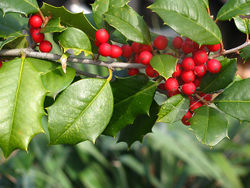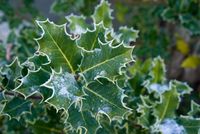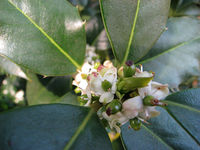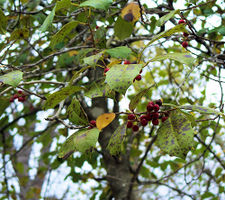Holly
| Holly |
|---|

|
| Scientific Classification |
|
| Species in the USA |
|
Holly is often called a bush, but is debated to be a tree. It is known for its bright red berries that contrast the other plants that grow in the winter. Often only thought of as a Christmas decoration, this plant has much more folklore and mythology behind it. It is an angiosperm and also a dioecious (holds both male and female flowers) plant. Only one plant holds both male and female flowers. These small white flowers grow in clumps and are hard to tell apart. What also differentiates this plant from others is its spiked leaves. It is often an understory growth and protects many small creatures with its tough leaves. The leaves are so waxy and strong that only few fungi are able to decompose it. The tough holly plant is native in coastal European countries like Denmark and Norway and has become an invasive species wherever it has been planted otherwise.
Body Design
The holly plant has a taproot and also a prolific lateral root system. They are dioecious which means that their small white flowers could be either male or female, but never both. Only the female flowers, pollinated by insects, produce the red berries that distinguish the holly plant. Both male and female flowers need to be present on a tree in order to produce fruit. The berries are about one cm in diameter and resemble a small Christmas ornament. One small berry includes four kernels. [3] These small flowers blossom in the late months of spring and grow annually in very large clumps very close to the older leaves of the plant. [4]
The leaves of a holly plant can be found both prickly and "prick-less" on the same plant. Closer to the ground, where animals like goats and deer feed on the plant, the leaves are extremely spiked and sharp. Towards the top of the tree or bush, the leaves become more smooth and rounded, this makes a great place for birds to nest. The leaves themselves are very tough and have a waxy coating. They do not smell, nor do they have much taste. When these leaves finally fall off of the plant, their toughness keeps them from shriveling up. They remain on the ground for an oddly long amount of time before shriveling up. [5]
Life Cycle
The holly plant is dioecious and produces both male and female flowers. Normally, honey bees pollinate these flowers. A male flower can fertilize up to eight female flowers. The pollen that is transferred from the male to the female travels down the pollen tube until it reaches and fertilizes the embryo. The pollen is formed when many microsporangium go through meiosis and then through mitosis to become a microgametophyte. This is a similar life cycle to all other dioecious plants. [6]
The berries of the holly plant are its fruit. Inside this fruit is the seeds. These seeds are made by the female flowers after fertilization. The berry, or seed coat, is formed by the matured ovary. Once the seed is shed, the fruit covering keeps it protected and stops it from growing until the conditions are favorable enough for it to thrive. Once germination finally occurs, the embryo forms into a diploid sporophyte. [7]
Ecology
Holly is often debated as a large shrub or an under story oakwood tree. It is also commonly known as European Holly because of its nativity in western coastal European countries such as Norway, Denmark, Germany, Britain, Ireland, Portugal, and Spain. It is also native to the Eastern United States. These tough plants grow best in very sunny places. As holly has been planted in other non-native countries, it has become invasive. It is one of the only evergreen broadleaf trees in Europe and is often used for food despite its spiky foliage. [8]
Holly parachute fungus is a fungi specifically associated with Holly. It exclusively breaks down the tough leaves of the holly plant like no other fungi can. “Holly speckle”, though, is the most commonly known decomposer of holly that shows up on the leaves as black spots. These microfungi are also important because there are very few animals that feed off of this plant. Even the insects that do eat holly only eat the shoots or flowers of the plant. Like any other flowering plant though, bees and wasps collect nectar from the holly flowers. This nectar is used to feed the bees and pollen to pollinate other flowers. The birds and other animals are fed by the berries as well. Even the leaves and foliage make good homes for animals. [9]
Folklore
Holly has many superstitions and beliefs tied to it. One of them is that holly was brought into a home to protect the family from violent fairies and other mythical creatures. Another belief was that, depending of the smoothness or prickliness of the leaves, the holly brought into a home would determine whether the husband or wife would be dominant in that coming year. Holly may seem to be a strictly winter-time associated plant, but this is not true. Like other trees in the olden times, holly was thought to protect farms and homes from the outside as well. It was often thought as bad luck to cut them, so people would leave them untrimmed and wild in hopes to keep witches away. Even though the felling of these trees was frowned upon, clipping their boughs for decoration and using them for animal fodder was necessary to a happy and “lucky” household. [10]
The ancient Druids thought holly to be a magical plant of eternal life and fertility because of its bright colors that never faded even in the winter months. They believed it was a symbol of hope and good fortune. Mythological gods like Thor and Taranis were often linked to the holly plant as well because of its good luck during lightning storms. The leaves act as lightning conductors, protecting everything around them from lighting strikes. We know now that this fact is true. The Romans also associated holly with their god, Saturn, the god of harvest. They would celebrate him by decorating their homes with bright holly plants in the midst of winter. Christians also relate holly to their religion, but not in a superstitious way. The spiky leaves represent Jesus’s crown of thorns and the red berries symbolize his blood on the cross. Boughs and wreaths of holly were used for many reasons, but the representation of Christ’s sacrifice is the most real and important of all. [11]
Video
Hollys After Holidays
There are many different types of hollys that are around at all times of the year.
References
- ↑ Plants profile: holly. USDA. Web. 2 June 2013 (Date-Accessed).
- ↑ Ilex Wikispecies. Web. 2 June 2013 (Date-Accessed).
- ↑ Aves, Melanie. The Root System of Holly Bushes. eHow. Web. May 27, 2011 (Date-Accessed).
- ↑ Grosse-Kleimann, Ralph. Holly Plant Study. Flower Society. Web. May 27, 2013 (Date-Accessed).
- ↑ A Prickly Subject Are Holly Leaves. Hubpages. Web. February 27, 2013 (Date-Updated).
- ↑ English Holly. Bioweb. Web. May 27, 2013 (Date-Accessed).
- ↑ Angiosperms Reproduction and Life Cycle. Cartage. Web. May 27, 2013 (Date-Accessed).
- ↑ Otis, Andrew. About The American Holly Tree. Ask.com. Web. December 22, 2011 (Date-Published).
- ↑ Holly. Trees For Life. Web. May 16, 2013 (Date-Accessed).
- ↑ Mythology and Folklore of the Holly Trees For Life. Web. May 16, 2013 (Date-Accessed).
- ↑ Holly Days of Yore Holly Hills Orchard. Web. May 16, 2013 (Date-Accessed).



